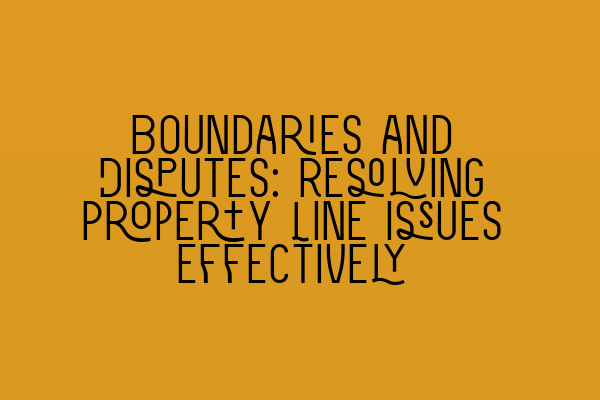Boundaries and Disputes: Resolving Property Line Issues Effectively
Welcome to our SQE Property Law & Land Law blog! In this post, we will explore a topic that is crucial for property owners and buyers: boundaries and disputes. Property line issues can be a common source of disagreements and legal disputes, and it is essential to address them effectively to protect your property rights and maintain a peaceful coexistence with your neighbors.
Before we dive into the details, make sure to check out our related articles for a comprehensive understanding of property laws and challenges:
– Updates in UK Property Laws: Key Changes and Implications
– Legal challenges in property transactions: A comprehensive guide
– Navigating Lease Laws in the UK: Essential Guidelines for Tenants and Landlords
– Dominate Property Law Questions: Avoiding Common Pitfalls
– Land Law Revision Tips: Ace Your Exam Preparation
The Importance of Clear Boundaries
Clear and well-defined boundaries play a crucial role in determining property ownership and ensuring peaceful coexistence between neighbors. A property’s boundaries define its limits and separate it from neighboring properties. They can be marked by physical features such as fences, walls, or natural landmarks, or they can be legally determined.
Clearly established boundaries not only prevent disputes but also provide certainty and security in property ownership. When buying a property, it is vital to understand its boundaries and ensure they align with what is depicted in the title deed and land registry records.
Common Causes of Boundary Disputes
Boundary disputes can arise due to various reasons, including:
- Unclear or Vague Boundaries: When the boundaries are not clearly specified or documented, disputes can arise over the exact location of the property lines.
- Encroachments: Encroachments occur when a structure, such as a fence, wall, or extension, crosses over the property line and encroaches onto a neighboring property.
- Disagreements Over Maintenance: Disputes can arise when there are disagreements between neighbors regarding the maintenance and upkeep of shared boundaries, such as boundary walls or hedges.
- Boundary Wall or Fence Disputes: Issues can arise when neighbors disagree on the ownership, maintenance, or cost-sharing of boundary walls or fences.
- Adverse Possession Claims: Adverse possession claims occur when someone has occupied and used a piece of land for a long period, leading to a dispute over the legal ownership of the property.
Resolving Boundary Disputes
When faced with a boundary dispute, it is essential to approach the situation with a calm and rational mindset. Here are some steps you can take to resolve property line issues effectively:
- Communication and Mediation: Open communication with your neighbor is often the first step in resolving a boundary dispute. Try to discuss the issue calmly and find a mutually agreeable solution. Mediation can also be a useful tool to facilitate productive conversations and find a compromise.
- Review Deeds and Land Registry Records: Review your property’s title deeds and land registry records to determine the exact boundaries. These documents should provide information about any rights of way or easements that may affect the boundaries.
- Seek Professional Surveying: Hiring a professional surveyor can help in accurately establishing the boundaries and resolving disputes based on factual evidence. The surveyor will assess physical features, historical records, and other relevant factors to determine the true boundary lines.
- Legal Advice: If the dispute persists, seeking legal advice from an experienced property solicitor is crucial. A solicitor can guide you through the legal process, review your documentation, and represent your interests in court if necessary.
- Alternative Dispute Resolution: Consider alternative dispute resolution methods such as arbitration or negotiation to reach a resolution without going to court. These methods can be more cost-effective and less adversarial than traditional litigation.
- Litigation: In some cases, litigation becomes necessary to resolve boundary disputes. A court can make a binding decision on the dispute based on the evidence presented by both parties.
Remember, each boundary dispute is unique, and the appropriate resolution method may vary. It is crucial to consult with a qualified property solicitor who can assess your specific situation and guide you through the process.
Preventing Boundary Disputes
An ounce of prevention is worth a pound of cure. While boundary disputes may not always be avoidable, taking proactive measures can minimize the risk. Here are some tips to help prevent boundary disputes:
- Understand and clarify property boundaries during the buying process. Review the title deeds, land registry records, and any relevant planning permissions or permits.
- Communicate openly and maintain good relationships with your neighbors. Regular discussions can help address potential issues early on.
- Mark and maintain your boundaries clearly. Use physical features such as fences, walls, or hedges to establish and maintain the boundaries.
- Document any agreements, easements, or shared maintenance responsibilities in writing to avoid future disputes.
- Regularly review and update your boundary information to ensure it aligns with the legal documentation. Changes to your property, such as extensions or renovations, may impact the boundaries.
By following these preventive measures, you can reduce the likelihood of boundary disputes and enjoy a peaceful coexistence with your neighbors.
We hope this blog post has provided valuable insights into resolving property line issues effectively. If you require legal assistance or advice regarding property law, feel free to reach out to our expert team at SQE Property Law & Land Law.
